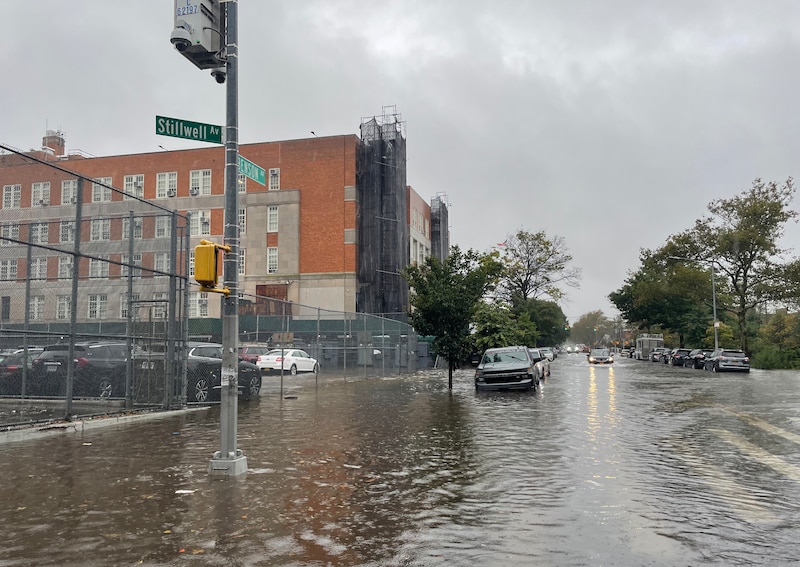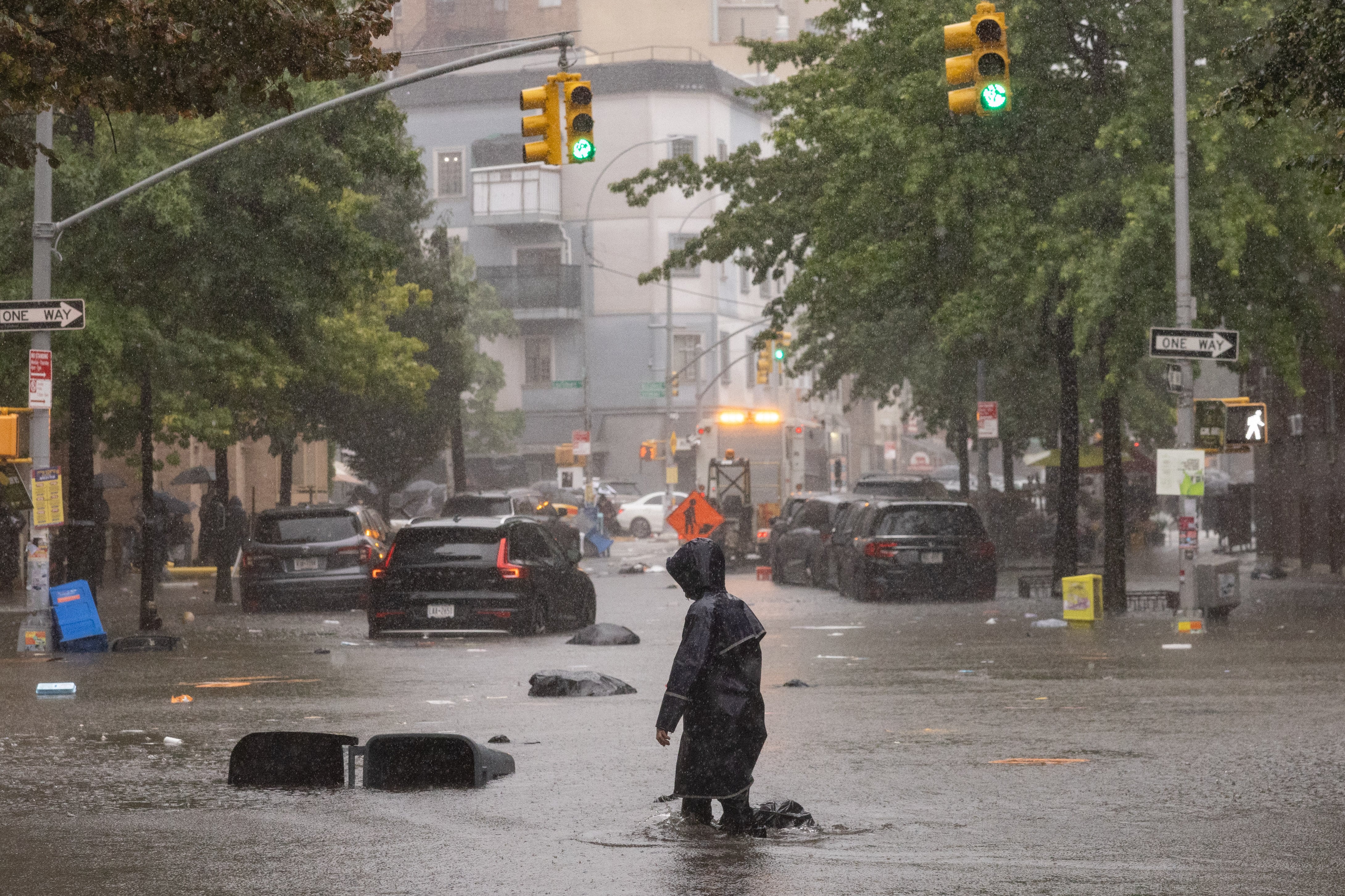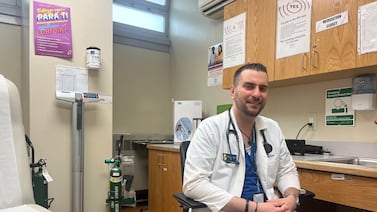Sign up for Chalkbeat New York’s free daily newsletter to keep up with NYC’s public schools.
As flood waters rose Friday in many parts of New York City, the message seemed clear cut.
“If you are at work or school, shelter in place for now,” said Mayor Eric Adams during a press conference about the storm just before noon that day. Schools Chancellor David Banks repeated that language later in the briefing, explaining “our protocol is in fact to shelter in place.” A social media post at 12:16 p.m. from the Education Department said the same.
Sheltering in place refers to a specific Education Department safety protocol that requires schools to shut their front doors, barring anyone from coming in or out. The procedure is meant to keep schools safe when there’s a danger outside the building.
At 1:56 p.m., a top Education Department official alerted principals that the “shelter in place has been lifted,” according to a copy of the email obtained by Chalkbeat.
There was just one problem: No one directly told schools about the order in the first place.
The email was the first Education Department communication that appeared in principals inboxes all day.
That was when Anna Nelson, an assistant principal at Bronx Latin, learned of the shelter-in-place directive.
But enforcing it would have been complicated. Many parents at her 6-12 school showed up early asking to pick up their children, fearing their commutes would be even harder later in the day due to the record rainfall. That would not have been allowed under a typical shelter-in-place order.
“Parents would have been really upset,” Nelson said. “It would have been wild.”
During previous shelter-in-place situations involving many schools, such as one for several Brooklyn schools after the subway shooting in Sunset Park last year, orders came from the NYPD and borough safety offices contacting schools.
But no such directives arrived Friday, 10 school administrators told Chalkbeat.
Flooding causes chaos in many schools
Many school leaders were dealing with immediate crises. They were helping kids dry off and scrounging up extra clothes for kids who were soaked through, while moving some children out of water-logged classrooms. They were ensuring floors weren’t dangerously slippery and figuring out if they had enough teachers to cover classes. They were communicating with concerned families about pickup and figuring out alternative exit plans for dismissal.
Many were unable to tune into the mayor’s press conference or monitor Education Department messages on X (formerly known as Twitter) during the middle of the school day — and may not even have known to watch for information through these channels.
As a result, none of the administrators who spoke with Chalkbeat actually implemented a shelter-in-place. Many were left on their own to figure out if and how to dismiss students early or let parents come and retrieve kids, with mixed messages swirling from higher-ups.
“It was very confusing honestly,” said one Brooklyn school administrator who spoke on the condition of anonymity because they were not authorized to talk to the media. “I was watching the press conference live and then I heard him say it, but I was like ‘I don’t think he really means we’re going to shelter in, because that’s crazy.’”
Education Department spokesperson Nathaniel Styer reiterated Monday that “guidance during inclement weather events is to take refuge in the school building.” When asked how the Education Department communicated that guidance, he pointed to the mayoral press conference and social media.
The idea of a blanket citywide shelter-in-place order seemed especially confusing to administrators because those directives are usually targeted at specific schools or neighborhoods, administrators said. While some schools with significant flooding outside may have benefited from such an order, it would have been a problem for other schools that needed to let students out early for safety reasons, they said.
Pointing to the need for a shelter in place, Styer said that some schools called parents and guardians to pick up children from school during Friday’s travel warnings, “which put even more members of our community in harm’s way.”
The end-of-day email to principals also suggested that schools should make sure students and staff are familiar with alternate evacuation routes, ensure children have a way to get home given disruptions to public transit, and keep a stock of supplies on hand including flashlights and blankets.
There was scarcely any time to do those things as the official guidance came less than an hour before dismissal, said Nelson, the Bronx administrator.
Though she said her school was largely spared from flooding and most of her students don’t commute long distances to the campus, she remained concerned about the lack of planning from the city.
“It is clear to me that we will have more flood issues like this in the future and the DOE doesn’t have any flood plans in place,” Nelson added.

At the Lafayette Educational Complex in Gravesend, Brooklyn, which is in a flood zone, students and staff had to wade through thigh-high waters to get to the schools housed there, said teacher Elizabeth Fortune. The building’s basement and cafeteria flooded, just as they did during Hurricane Sandy in 2012, and she worried the building would face flooding in the future.
“We gave away all our school logo pjs to students and some were stuck in wet clothes or barefoot at school,” Fortune wrote in an email. “Once the waters began to recede, many older students wished to leave, but we were required to hold them until a parent could pick them up. Parents themselves were stranded without any ability to get to the school.”
Communication breakdown sows confusion
A total of 336 city public schools required cleanup over the weekend due to flooding, Styer said. On Friday, city officials said 150 schools were affected.
One school, P.S. 312 in Bergen Beach (originally reported by the Education Department as P.S. 132), had to be evacuated because of a smoking boiler. That school reopened Monday, and the “vast majority” of water issues across city schools were “minor, requiring only mopping,” he said.
To some educators, the botched communication over the shelter-in-place order felt emblematic of larger failures to give schools clear and timely guidance during a crisis. If top city officials misspoke about the shelter-in order, they should have clarified that immediately, said one Manhattan school administrator.
“The lack of communication is what creates people making up their own stories,” said the administrator, who spoke on the condition of anonymity. “If this isn’t the policy, and someone made a mistake, just own that and keep it pushing.”
Instead, school leaders were left largely on their own to figure out the protocol — and the confusion trickled down to teachers and parents.
Some schools let students out early. Anxious parents showed up to retrieve kids, and some students feared longer-than-normal commutes on public transit.
“A lot of our kids travel an hour each way on a good day,” said the Brooklyn administrator. “We don’t want kids traveling on buses they don’t normally take in the dark.”
Brooklyn dad Geoff Sanoff, who has two children in two different high schools, recounted the widely varied response from his children’s schools.
At Brooklyn Tech, where one son attends, the school emailed families about what they were doing, where families should go to meet their teens, and options for kids to stay in the building as they waited to get picked up. At the smaller Brooklyn high school his other son attends, there was “radio silence,” Sanoff said.
Brooklyn Tech is walkable to their Park Slope home, so the commute home for that son was doable. The other school, however, is accessible by the G train, which was not running. Sanoff’s son at that school, a freshman, wasn’t sure what to do, or where to wait to be picked up since he was not allowed to stay inside the building.
“With no subway, getting home from school turned into a three-hour round trip in a grandparent’s car to pick him up,” Sanoff said, adding that his son waited outside for more than an hour.
Sanoff understands that Brooklyn Tech — which is the nation’s largest high school with nearly 6,000 students — has kids from across the city and needs to be on top of coordinating its communications. His other son’s school, which may serve more kids who live locally, may not have realized that new students who travel further may have needed more help and may not have known who to ask for help, he said.
“It kind of baffles me that nobody said anything to him,” Sanoff said. “I am not angry with them, just frustrated at this situation. At the end of the day, the real question to me is, ‘How is it that each school has been left to fend for itself in a situation like this? Has there been no guidance from on high?’ No thought for school buses to be set aside, nothing from the DOE to help parents and schools know where to go, what to do, or who to reach out to for help.”
Michael Elsen-Rooney is a reporter for Chalkbeat New York, covering NYC public schools. Contact Michael at melsen-rooney@chalkbeat.org.
Amy Zimmer is the bureau chief for Chalkbeat New York. Contact Amy at azimmer@chalkbeat.org.
Alex Zimmerman is a reporter for Chalkbeat New York, covering NYC public schools. Contact Alex at azimmerman@chalkbeat.org.






